cisco 800-150 practice test
Supporting Cisco Devices for Field Technicians
Question 1
[Cisco Equipment and Related Hardware]
What is the primary role of a switch in a local area network?
- A. to route data packets between different networks
- B. to encrypt data transmissions for security
- C. to divide the network into separate collision domains
- D. to provide wireless connectivity to LAN devices
Answer:
C
Explanation:
In a local area network (LAN), the primary function of a switch is to operate at Layer 2 (Data Link
Layer) of the OSI model. Switches use MAC addresses to forward frames to the appropriate
destination ports. This targeted forwarding mechanism divides the network into separate collision
domains for each switch port. By isolating collision domains, switches significantly reduce the chance
of collisions, enhancing the performance and efficiency of the network.
Unlike hubs, which forward all traffic to all ports (thus creating a single collision domain), switches
intelligently forward only the necessary traffic to the correct port. This capability allows multiple
simultaneous conversations on different switch ports without interference.
Routers, which operate at Layer 3 (Network Layer), are used to route packets between different
networks, not within the same LAN. Wireless connectivity is provided by wireless access points
(WAPs), not switches. Encryption is typically handled by security protocols or devices such as
firewalls and not by switches directly.
Reference: Supporting Cisco Devices for Field Technicians (FLDTEC) – Cisco Equipment and Related
Hardware
Question 2
[Cisco Equipment and Related Hardware]
Which Layer 2 technology extends to access layer devices, allowing individual switch ports to be
assigned for network and traffic management in an enterprise network?
- A. BGP
- B. VLANs
- C. OSPF
- D. MPLS
Answer:
B
Explanation:
In an enterprise network, Virtual Local Area Networks (VLANs) are the key Layer 2 technology used
to logically segment a network into multiple broadcast domains. VLANs allow network
administrators to assign individual switch ports to specific VLANs, enabling effective network
segmentation and traffic management.
This configuration extends to access layer devices, such as switches where end-user devices connect.
By isolating traffic into VLANs, administrators can improve network performance, enhance security
by separating sensitive departments (such as finance and HR), and simplify network management.
Unlike routing protocols such as BGP and OSPF, which operate at Layer 3, or MPLS, which is a Layer
2.5 forwarding technology used primarily in service provider networks, VLANs are explicitly designed
for Layer 2 segmentation within LAN environments.
Reference: Supporting Cisco Devices for Field Technicians (FLDTEC) – Cisco Equipment and Related
Hardware
Question 3
DRAG DROP
[Device Configuration and Verification]
Drag and drop the network connectivity and management tools used to ensure connectivity from the
left onto the description on the right.
Answer:
PING → Sends ICMP echo request packets to verify connectivity
Telnet → Allows virtual terminal connections with unencrypted traffic
SSH → Provides secure, encrypted remote access to network devices
IP address configuration → Requires the PC and Cisco device to be in the same subnet for direct
connection
These tools and their functions are covered under “Device Configuration and Verification” in the
Utilized to test basic network connectivity using ICMP echo request/reply messages. It
confirms whether a device is reachable and measures the round-trip time.
A protocol that allows for remote device access but transmits data in plaintext, which makes
it insecure. It's typically disabled by default on modern Cisco devices due to security concerns.
Replaces Telnet as the preferred method for secure CLI access. It encrypts the
session, protecting sensitive information such as login credentials.
For direct device access via the same local network, both the PC and the
Cisco device must be in the same subnet. This allows the use of tools like browser-based GUIs or
terminal emulators when connecting directly.
Question 4
[Troubleshooting Methodologies]
Which scenario would result in a speed mismatch when configuring Ethernet devices with different
speed settings?
- A. One end is manually set to 1 Gbps, and the other end is manually set to 100 Mbps
- B. Both ends are manually set to the same speed
- C. One end is manually set to 100 Mbps, and the other end is set to auto-negotiation
- D. Both ends are set to auto-negotiation and fail, reverting to their lowest speeds
Answer:
A
Explanation:
A speed mismatch occurs when two connected Ethernet devices are configured to operate at
different speeds. In scenario A, one device is manually set to 1 Gbps, while the other is set to 100
Mbps. Since both ends are hard-coded to different speeds, they cannot successfully negotiate a
common speed, leading to a mismatch and resulting in a failed or unstable link.
In contrast, scenario B, where both ends are manually set to the same speed, ensures compatibility
and stable communication. Scenario C can lead to a duplex mismatch rather than a speed mismatch;
the auto-negotiating end may default to half-duplex if it cannot determine the duplex setting of the
manually configured end. Scenario D is less common; if auto-negotiation fails, devices may revert to
their lowest common speed, but this typically results in reduced performance rather than a complete
mismatch.
Reference: Supporting Cisco Devices for Field Technicians (FLDTEC) – Troubleshooting Methodologies
===========
Question 5
[Cisco IOS Software Basics]
Which layer of the OSI model provides error detection and defines how access to the media is
controlled?
- A. Presentation layer
- B. Physical layer
- C. Network layer
- D. Data link layer
Answer:
D
Explanation:
The Data Link Layer (Layer 2) of the OSI model is responsible for node-to-node data transfer and plays
a crucial role in error detection and media access control. It ensures that data frames are transmitted
to the correct device on a local network segment.
This layer is divided into two sublayers:
Logical Link Control (LLC): Manages frame synchronization, flow control, and error checking.
Media Access Control (MAC): Controls how devices on the network gain access to the medium and
permission to transmit data.
Together, these sublayers ensure reliable data transmission by detecting and possibly correcting
errors that may occur in the Physical Layer. They also manage how devices share the transmission
medium, preventing collisions and ensuring orderly communication.
Reference: Supporting Cisco Devices for Field Technicians (FLDTEC) – Cisco IOS Software Basics
Question 6
DRAG DROP
[Cisco Equipment and Related Hardware]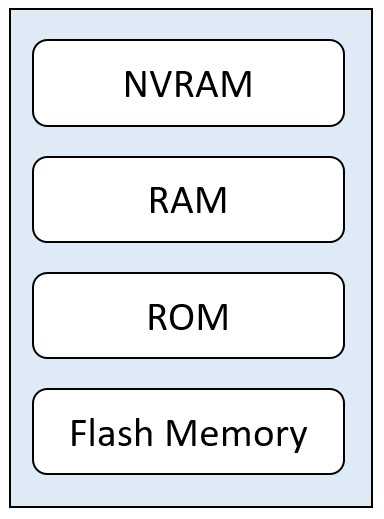
Refer to the exhibit. Drag and drop the functions from the left onto the corresponding internal
memory components on the right.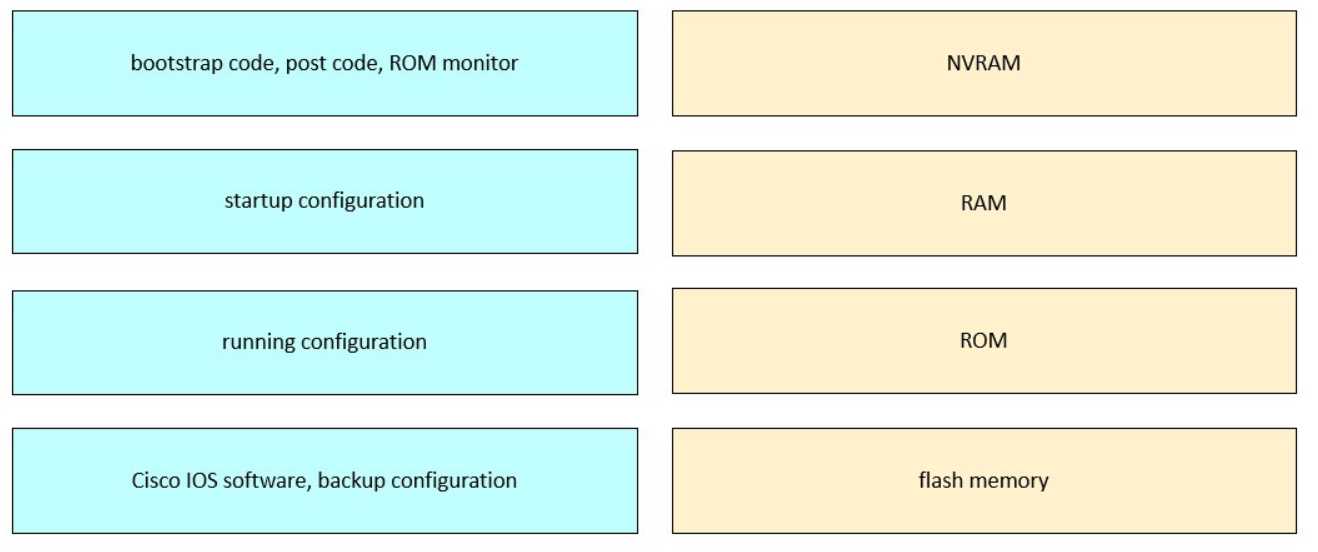
Answer:
Explanation: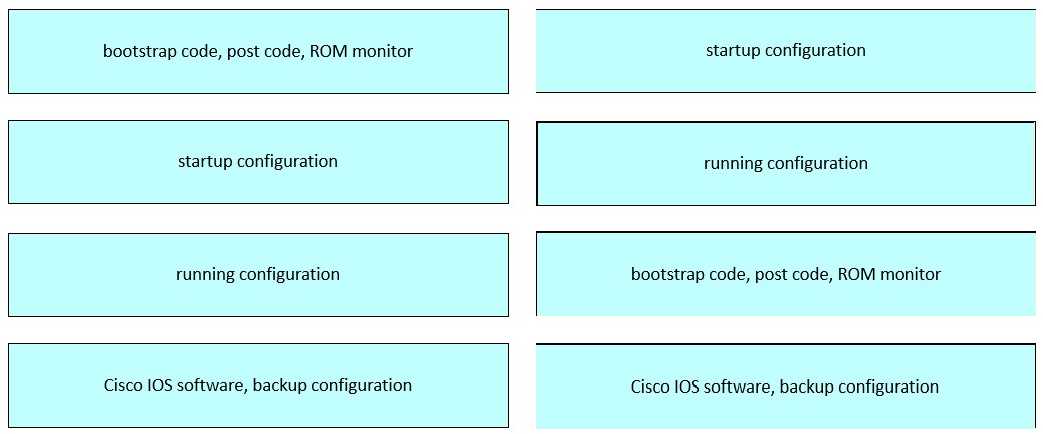
NVRAM → Startup configuration
RAM → Running configuration
ROM → Bootstrap code, POST code, ROM monitor
Flash memory → Cisco IOS software, backup configuration
Each memory type in a Cisco device serves a specific function in the boot process and runtime
operation. NVRAM retains configuration across reboots, RAM is volatile and holds active configs,
ROM handles initial boot tasks, and flash stores the operating system.
This content is covered thoroughly in "Cisco Equipment and Related Hardware" in the FLDTEC
curriculum. Here's the breakdown:
ROM (Read-Only Memory)
Stores bootstrap code, POST (Power-On Self-Test), and ROM Monitor.
These are essential for the device’s initial power-on operations and recovery modes.
NVRAM (Non-Volatile RAM)
Holds the startup configuration file, which is loaded during the boot process.
Content remains intact after a reboot or power cycle.
RAM (Random Access Memory)
Stores the running configuration and current operational state of the router or switch.
Also used for routing tables, ARP cache, and packet buffers.
Data is lost when the device is powered off or rebooted.
Flash Memory
Contains the Cisco IOS image, system files, and can store backup configurations.
It is a non-volatile storage, so it retains data after reboots.
Question 7
[Cisco Equipment and Related Hardware]
Which two devices are most commonly used in a WAN environment? (Choose two.)
- A. Hubs
- B. Optical fiber converters
- C. Modems
- D. Network interface cards
- E. Wireless access points
Answer:
BC
Explanation:
In the context of Wide Area Networks (WANs), the key objective is to connect geographically
separated networks using service provider infrastructure. The FLDTEC course emphasizes that WAN
environments typically involve devices that can handle different physical transmission mediums and
protocols.
Modems:
Modulate and demodulate analog signals to digital signals.
Used in WAN environments to connect over analog lines like DSL or leased lines.
Essential for interfacing between digital routers and analog telephone networks.
Optical Fiber Converters:
Also known as media converters, they are used to convert electrical signals to optical signals (and
vice versa) for fiber transmission.
Common in WAN scenarios where long-distance high-speed transmission over fiber is required.
Incorrect Options:
A . Hubs: Obsolete Layer 1 devices used in LANs, not suitable for WANs.
D . Network Interface Cards (NICs): Used in end devices for LAN connectivity.
E . Wireless Access Points: Typically used in WLANs within local premises, not WAN infrastructure.
This aligns with Cisco’s WAN architecture fundamentals as highlighted in FLDTEC under “Cisco
Equipment and Related Hardware.”
Question 8
[Cisco IOS Software Basics]
What is the purpose of a subnet mask?
- A. Distinguishes the network and host segments
- B. Provides encryption for network traffic
- C. Determines the next-hop router
- D. Aids in route prioritization
Answer:
A
Explanation:
A subnet mask is a 32-bit number used in IP networking to divide an IP address into network and
host portions. This division is crucial for routing traffic within and between networks. The subnet
mask works in tandem with the IP address to identify which part of the address refers to the network
and which part refers to the host. This distinction allows for efficient IP address allocation and
routing.
For example, in the IP address 192.168.1.10 with a subnet mask of 255.255.255.0, the first three
octets (192.168.1) represent the network portion, while the last octet (10) identifies the specific host
within that network.
Reference: Supporting Cisco Devices for Field Technicians (FLDTEC) – Cisco IOS Software Basics
Question 9
DRAG DROP
[Device Configuration and Verification]
Drag and drop the descriptions from the left onto the corresponding IPv4 addressing modes on the
right.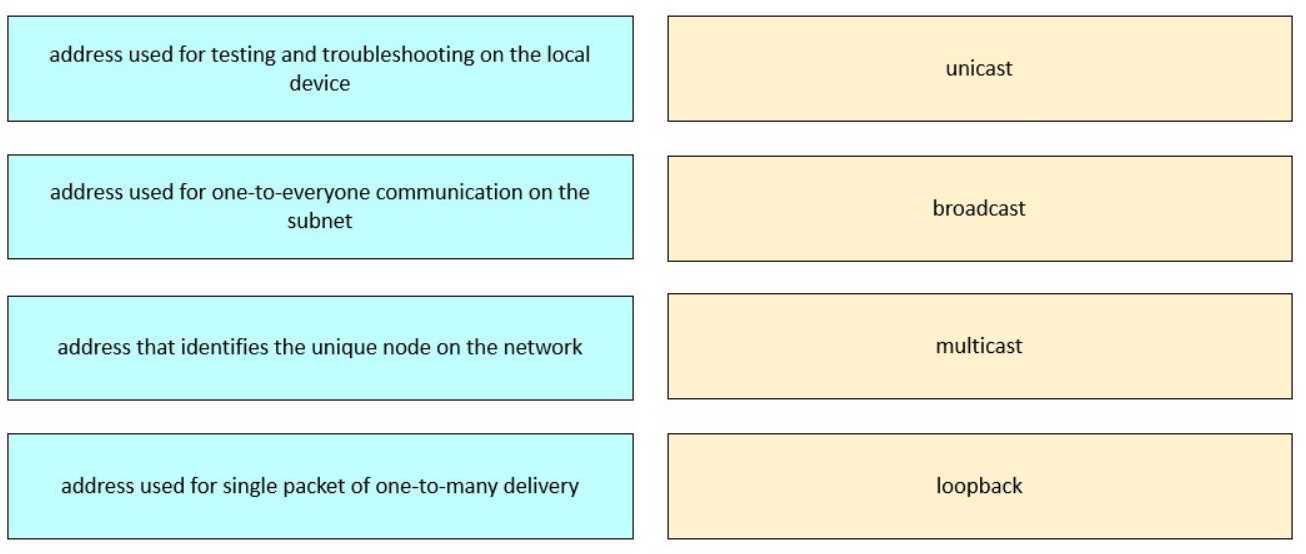
Answer:
Explanation:
This content is aligned with IPv4 Addressing Fundamentals, detailed in the FLDTEC course under
Device Configuration and Verification:
Unicast: A unicast address uniquely identifies a single host on a network. This is the most common
address type used for standard communication between two devices.
Broadcast: Broadcast addresses (e.g., 255.255.255.255 or subnet-specific broadcast) send traffic to all
hosts in the network segment. Used for ARP requests and DHCP discovery.
Multicast: Used to deliver a packet to a group of hosts interested in the data, without flooding the
network like a broadcast. Multicast uses addresses from the range 224.0.0.0 to 239.255.255.255.
Loopback: The loopback address (127.0.0.1) is reserved for local testing, ensuring that the TCP/IP
stack is working properly without needing to access the network.
Question 10
[Cisco Equipment and Related Hardware]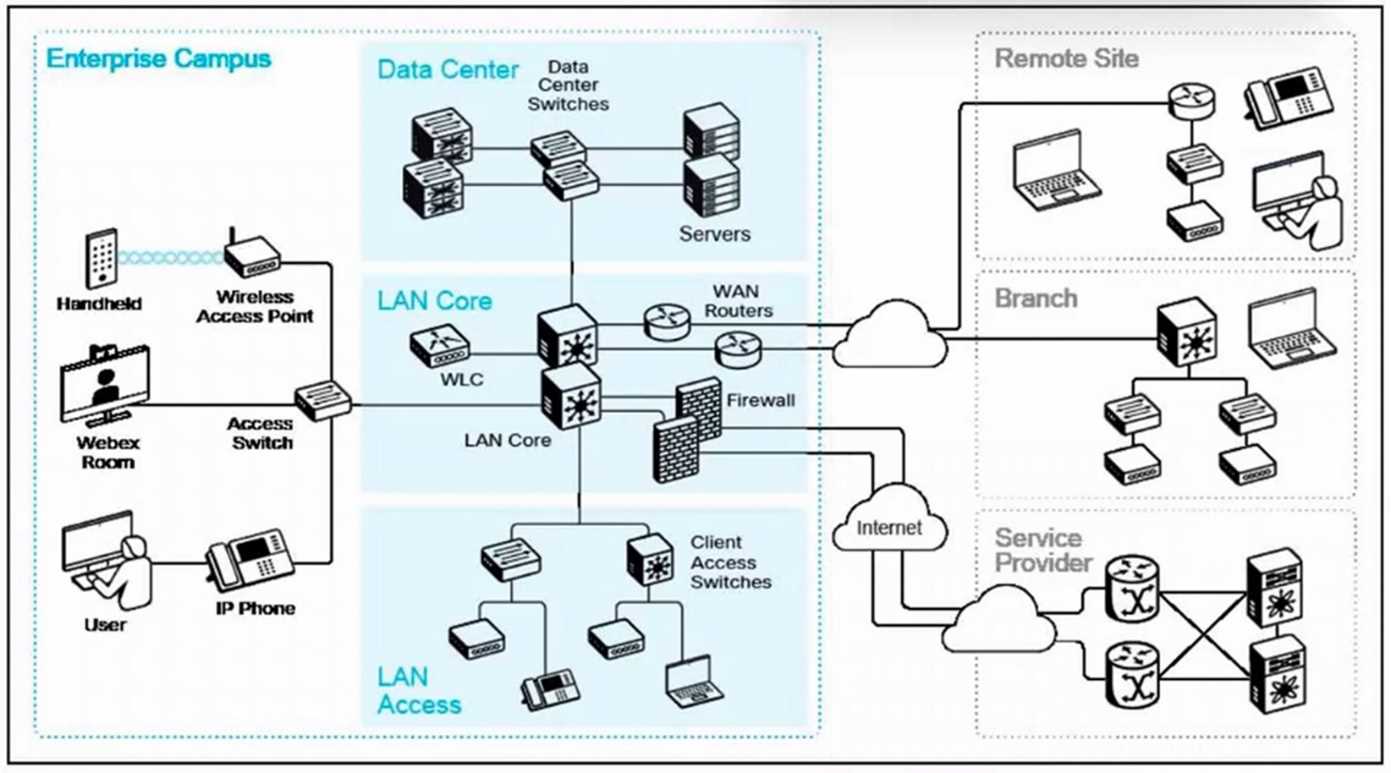
Refer to the exhibit. What are two ways remote sites or branches connect to the enterprise campus
network? (Choose two.)
- A. Access layer switches
- B. WAN links
- C. IPsec VPN tunnels
- D. Ad hoc Wi-Fi network
- E. LAN core switches
Answer:
B, C
Explanation:
In enterprise networking, remote sites or branch offices connect to the central campus network
using:
WAN Links: These are dedicated communication paths that connect geographically dispersed
networks. WAN links can be leased lines, MPLS circuits, or other forms of long-distance connectivity
that facilitate reliable data transmission between remote sites and the main campus.
IPsec VPN Tunnels: Internet Protocol Security (IPsec) VPNs provide secure, encrypted tunnels over
the public internet, allowing remote sites to connect to the enterprise network securely. This method
is cost-effective and widely used for connecting branch offices to the central network infrastructure.
Access layer switches (Option A) and LAN core switches (Option E) are components within a local
network and do not facilitate remote connectivity. Ad hoc Wi-Fi networks (Option D) are temporary
and lack the security and reliability required for enterprise-level remote connections.
Reference: Supporting Cisco Devices for Field Technicians (FLDTEC) – Cisco Equipment and Related
Hardware
===========
Question 11
[Cisco Equipment and Related Hardware]
When should a crossover UTP cable be used instead of a straight-through cable when connecting
network devices?
- A. To connect electrically like devices
- B. To connect a PC to a wireless access point
- C. To connect a switch to a router
- D. To connect electrically unlike devices
Answer:
A
Explanation:
A crossover UTP (Unshielded Twisted Pair) cable is used to connect two similar devices directly. This
includes:
Switch to switch
Router to router
PC to PC
The crossover cable reverses the transmit and receive pairs, allowing for proper communication
between like devices without the need for an intermediary device.
Conversely, a straight-through cable is used to connect dissimilar devices, such as:
PC to switch
Router to switch
PC to router
This cable maintains the same wiring on both ends, suitable for connecting different types of devices.
Therefore, when connecting electrically like devices, a crossover cable is appropriate.
Reference: Supporting Cisco Devices for Field Technicians (FLDTEC) – Cisco Equipment and Related
Hardware
===========
Question 12
[Cisco IOS Software Basics]
How many bits are borrowed from the default host portion of the address to create subnets in a Class
B network with a subnet mask 255.255.255.0?
- B. 5 bits
- C. 3 bits
- D. 8 bits
Answer:
D
Explanation:
In a Class B network, the default subnet mask is 255.255.0.0, which allocates:
16 bits for the network portion
16 bits for the host portion
When the subnet mask is changed to 255.255.255.0, it becomes:
24 bits for the network portion
8 bits for the host portion
This indicates that 8 bits have been borrowed from the host portion to create additional subnets.
Borrowing bits allows for the division of the original network into smaller sub-networks, enhancing
organization and security within the network.
Reference: Supporting Cisco Devices for Field Technicians (FLDTEC) – Cisco IOS Software Basics
Question 13
[Cisco Equipment and Related Hardware]
What is the function of an access layer device?
- A. Provides high-speed data transport between buildings or different parts of the campus
- B. Serves as the entry point for end-user devices to connect to the network
- C. Provides secure external access to internal network components
- D. Connects remote offices to the main corporate network
Answer:
B
Explanation:
In the hierarchical network design model, the access layer is the first layer and serves as the entry
point for end-user devices to connect to the network. This layer connects user devices such as PCs, IP
phones, wireless access points, printers, and scanners to the network. It facilitates the initial
connection between end-user devices and the network infrastructure. The access layer also enforces
security policies and provides services such as VLAN membership, port security, and Quality of
Service (QoS).
Options A, C, and D refer to functions typically associated with the core or distribution layers, or with
WAN connectivity, rather than the access layer.
Reference: Supporting Cisco Devices for Field Technicians (FLDTEC) – Cisco Equipment and Related
Hardware
===========
Question 14
[Wireless Device Support]
Which term describes the physical range of radio frequency coverage provided by an access point in
a wireless topology?
- A. Service Set Identifier (SSID)
- B. Basic Service Area (BSA)
- C. Wireless LAN (WLAN)
- D. Wireless LAN Controller (WLC)
Answer:
B
Explanation:
In wireless networking, the Basic Service Area (BSA) refers to the physical area of radio frequency
coverage provided by an access point (AP) in a Basic Service Set (BSS). The BSA defines the coverage
area where wireless clients can connect to the network through the AP. The size and shape of a BSA
depend on various factors, including the AP's transmit power, antenna type, and physical
environment.
Option A, the Service Set Identifier (SSID), is the network name broadcast by the AP. Option C,
Wireless LAN (WLAN), refers to the overall wireless network. Option D, Wireless LAN Controller
(WLC), is a device that manages multiple APs in a network.
Reference: Supporting Cisco Devices for Field Technicians (FLDTEC) – Wireless Device Support
===========
Question 15
[Device Configuration and Verification]
Which two configuration parameters are most critical to ensure optimal performance when
configuring a network port for a newly installed IP phone in an enterprise environment? (Choose
two.)
- A. VLAN assignment
- B. Link aggregation
- C. Spanning Tree Protocol
- D. Power over Ethernet
- E. QoS classification
Answer:
A, D
Explanation:
When configuring a network port for a newly installed IP phone, two critical parameters to ensure
optimal performance are:
VLAN Assignment: Assigning the correct VLANs is essential for segregating voice and data traffic.
Typically, a separate voice VLAN is configured to prioritize voice traffic and enhance security.
Power over Ethernet (PoE): PoE allows the switch to supply power to the IP phone over the same
Ethernet cable used for data transmission. This eliminates the need for separate power supplies and
simplifies installation.
While QoS classification (Option E) is important for prioritizing voice traffic, it is typically configured
at a broader network level. Link aggregation (Option B) and Spanning Tree Protocol (Option C) are
more relevant to network redundancy and loop prevention, respectively, and are not directly critical
for the initial configuration of an IP phone port.
Reference: Supporting Cisco Devices for Field Technicians (FLDTEC) – Device Configuration and
Verification
===